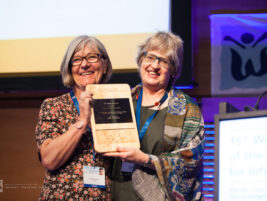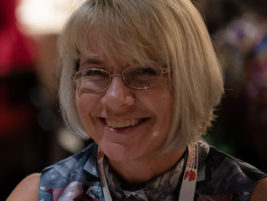In the context of visits to orphanages and hospitals in Central America and India, I have developed a model for mental health professionals in developed countries to volunteer their consultation services to caregivers of children in developing countries, in a long-term relationship, with episodic visits and regular skype contact. What appears in this issue of Perspectives is an excerpt from my blog, Supporting Child Caregivers. Three critical points of this model of volunteering are (1) the relationship is with the caregivers, instead of the children; (2) there is a commitment to a long-term relationship; (3) the focus is on the questions and concerns of the caregivers, not an external agenda.
I have been visiting a children’s home in El Salvador for 10 years. My visits are short – 4 or 5 days – once to three times a year. Over this period of time I have developed a consultative relationship with the director and caregivers in the home and offered workshops, followed by weekly skype contact with the director after my return to the U.S. The orphanage is a small Christian children’s home that included 27 children when I first came and recently has many fewer because of the national law, LEPINA.
The workshops take place in the orphanage during a weekday, when the children are in school. They begin with coffee and pastry, and there is a break for a special lunch, which I sponsor. The format is a power point presentation with accompanying video. Following a consultation model, the workshops focus on the caregivers’ chief concerns, underscored by the consistent message of the importance of the relationship. Videotapes of the same caregivers engaging in interaction with children are used to illustrate successful caregiving techniques, while also demonstrating how the caregiver’s ability to imagine the mind of the child is crucial. Discussion is encouraged throughout the presentation. In one workshop, I tried to engage the caregivers’ discouragement in dealing with the challenges presented by neglected and maltreated children by describing the potential value of every small success. I called each “repair” of a strain or rupture in the caregiving relationship a “momento magico”, magic moment, and proposed that these magic moments add up like grains of sand falling on a flat surface, to eventually build a castle.
After the first workshop, examples of the caregivers’ evaluations included, “It is good what you said, but now you should tell the children to do what we tell them to do.” Examples of evaluations after subsequent workshops included, “ I learned that it’s important to get down to a child’s level and listen to him, before I set a limit.” And “How to have a better relationship with a child and how to understand his situation.”
Throughout the rest of the year, I have weekly skype sessions with the Director, D. An example of a skype: In a meeting with the teachers, D felt frustrated when teachers implied that the children were neglected. One teacher said the children do well in school but do not bring in their homework. I suggest – because this has been successful in the past – the possibility of a community meeting in which all the children at the home are invited to brainstorm how to stay on top of their homework. D says that is a good idea. She will try it and let me know how it went. We talk about how much responsibility to expect from a 10-yo with his homework. A caregiver is leaving, and we talk about how to prepare the children for this loss – which children will be most affected, how they might express their distress, how to say good bye.
I have also begun traveling to India. There I have been visiting a Hindu orphanage in South India and a mission hospital in North India. My second visit was in February 2014, when I was accompanied by a colleague, Ginger Gregory . In our February visit to the hospital, Ginger and I gave a workshop at the nursing school with a focus on supporting the first relationship. 80 nursing students, as well as nursing school faculty, attended the workshop
Using Kevin Nugent’s excellent book, Your Baby is Speaking to You (Nugent, 2011), Ginger and I emphasized three points:
(1) Babies are speaking to their mothers; (2) Mothers can listen to their babies; and (3) Nurses can help mothers listen to their babies in a way that can influence the future health and well being of the children. We stressed the importance of making the mother feel competent to understand the communications of her own baby. Since there were clearly too many students to visit the new mother in the ward at the time, Ginger and I improvised. To illustrate our points, Ginger played the role of the mother, and I played the role of the nurse. This spontaneous role-playing introduced playfulness and humor into the classroom and was such as success that I think we will use it again. As usual, eliciting the help of the translator added another dimension of cultural richness and respect to the consultation process.
My wish is to interest other professionals in developed countries – such as many represented in WAIMH – in trying this type of volunteering as a way of contributing the advantages of our knowledge and experience to caregivers in developing countries, in a respectful and responsive manner, and that also does not require us to disrupt our own lives.
Reference
Nugent, Kevin (2012). Your Baby is Speaking to You. Houghton Mifflin Harcourt Publishing.
Authors
Harrison, Alexandra Murray,
Boston, USA








